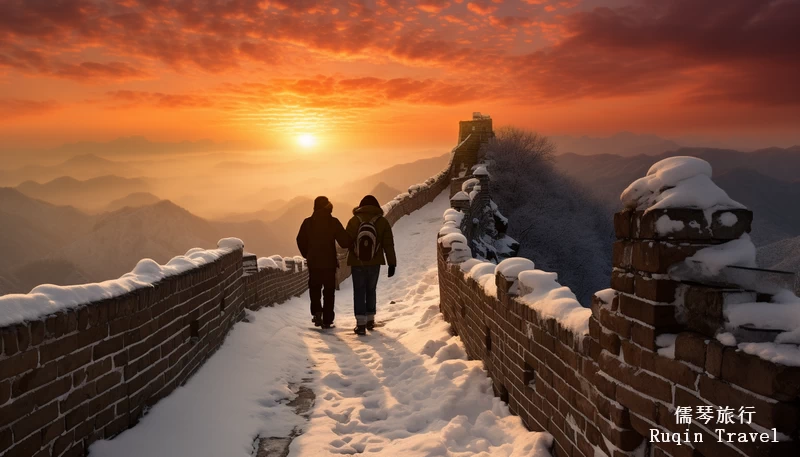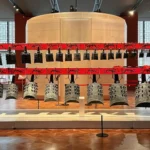Plan your Great Wall Tour? The Great Wall of China is a must-see destination for any visitor to Beijing. While the Wall is spectacular year-round, visiting it in winter offers a unique and enchanting experience. This “Great Wall of China in winter from Beijing” guide will help you plan your visit to the Great Wall of China during the winter months.
Why Visit the Great Wall in Winter?
Visiting the Great Wall of China in winter has several advantages. Firstly, the snow-covered landscape (if you are lucky to have snow) is breathtaking. The Wall looks like a dragon snaking through a snowy wonderland.
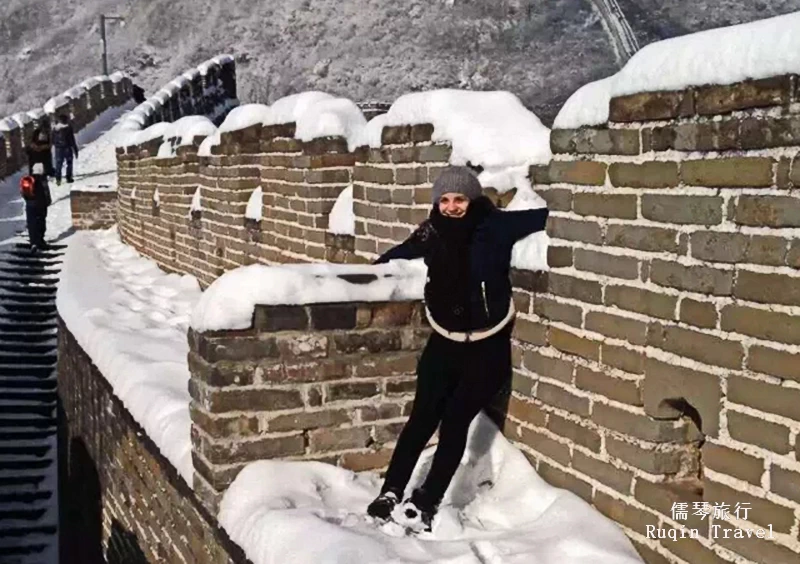
Secondly, there are fewer tourists during the winter months, allowing you to enjoy the Wall’s majesty in relative solitude. Thirdly, the crisp winter air offers clear views of the surrounding mountains.
When is Winter in Beijing?
Winter in Beijing starts in late November and lasts until early March. The coldest months are December, January, and February. During this time, temperatures can drop significantly. It’s essential to dress warmly and prepare for cold weather conditions.
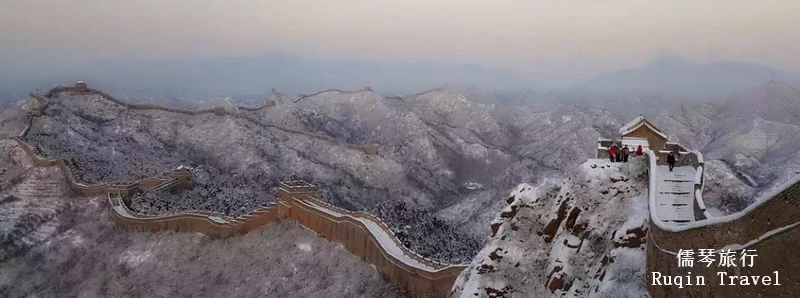
For a more comfortable experience, aim for a day with milder temperatures and less wind. Here’s a quick temperature guide:
November: -4 – 8℃
December: -12 – -1℃
January: -12 – 1℃
Best Sections to Visit in Winter
There are several sections of the Great Wall that are accessible from Beijing. Each offers a unique experience, especially in winter.
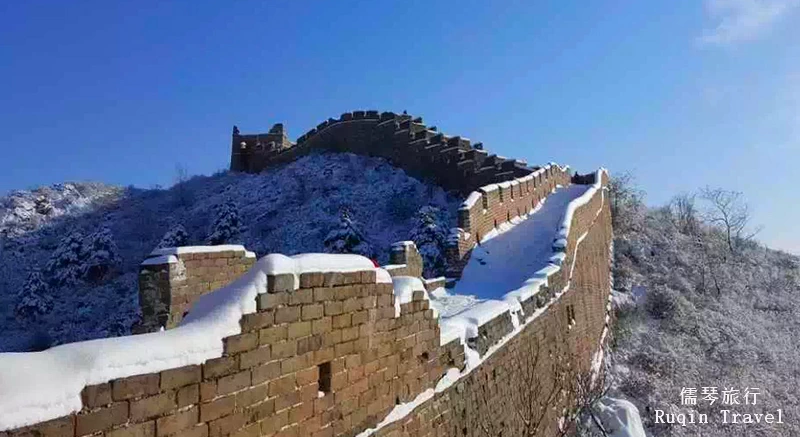
Mutianyu Great Wall
Mutianyu is one of the best-preserved sections of the Great Wall. It is also less crowded than the popular Badaling section. In winter, the snow-covered Wall at Mutianyu is a sight to behold.
The cable car and chair lift make it easier to access, and the toboggan ride down is an exhilarating experience.
Badaling Great Wall
Badaling is the most famous and visited section of the Great Wall. While it can be crowded during peak seasons, winter sees fewer visitors.
The Wall at Badaling is well-restored and offers stunning views. The Great Wall Museum and the circular screen cinema provide additional attractions.
Jinshanling Great Wall
For a more rugged and authentic experience, Jinshanling is an excellent choice. This section is partially restored, giving you a glimpse of the Wall’s original condition.
The snow-covered towers and battlements create a dramatic scene. However, this section requires more physical effort to explore, so be prepared for a challenging hike.
Preparing for Your Visit
Weather at the Great Wall of China
The weather at the Great Wall in winter can be harsh. Temperatures can range from -10°C to 5°C (14°F to 41°F).
Snowfall is common, especially in December and January. It’s crucial to check the weather forecast before your visit to ensure you are adequately prepared.
What to Wear
Dressing appropriately for the cold weather is essential. Here are some tips:
- Wear layers of warm clothing, including thermal underwear, sweaters, and a down jacket.
- A hat, gloves, and a scarf are necessary to protect against the cold wind.
- Wear sturdy, insulated boots with good traction to navigate the snowy and icy paths.
- Sunglasses and sunscreen are important to protect against the sun’s glare on the snow.
What to Bring
Bringing the right items can make your visit more comfortable:
- A small backpack for carrying essentials.
- Snacks and water to stay energized and hydrated.
- A camera or smartphone to capture the stunning winter scenery.
- Hand warmers for extra warmth during your hike.
- A map of the Great Wall section you are visiting.
Getting to the Great Wall in winter
From Beijing to Mutianyu
Mutianyu Great Wall is approximately 80 kilometers from downtown Beijing. There are several ways to get there:
Check out How to Get to Mutianyu Great Wall for more imformation.
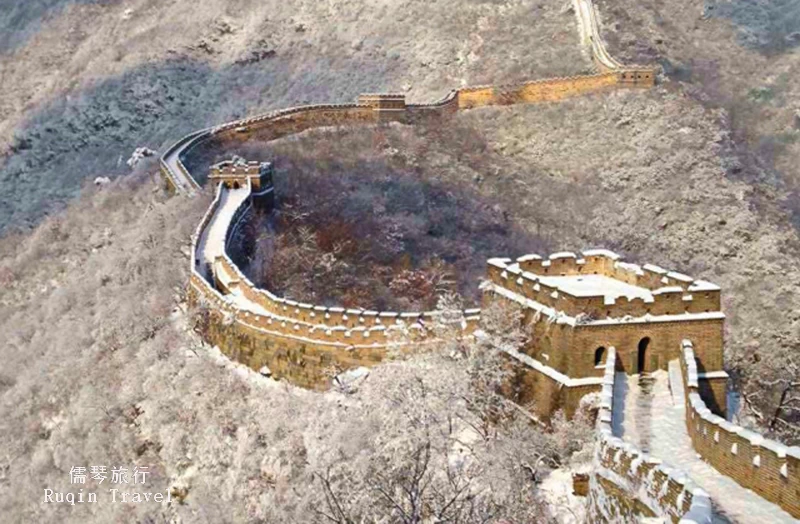
- By Bus: Take the 916 Express bus from Dongzhimen to Huairou North Avenue, then transfer to a local bus or taxi to Mutianyu.
- By Private Car: Hiring a private car or taxi is a convenient option. The journey takes about 1.5 hours.
- By Tour: Many tour companies offer day trips to Mutianyu, including transportation and guides.
From Beijing to Badaling
Check out How to get to Badaling Great Wall for more information.
Badaling Great Wall is about 80 kilometers from downtown Beijing. Here are your options:
- By High-speed Train: Take the high-speed train from Beijing Qinghe Railway Station to Badaling Great Wall Railway Station. The train ride takes about half a hour.
- By Bus: Bus 877 from Deshengmen Bus Station goes directly to Badaling. The journey takes about 1.5 hours.
- By Private Car: Hiring a private car or taxi is convenient and takes about an hour.
From Beijing to Jinshanling
Jinshanling is around 130 kilometers from Beijing. Getting there involves:
Check out: How to get to Jinshanling Great Wall from Beijing
By Bus: Take a long-distance bus from Wangjing West Station to Luanping, then a taxi to Jinshanling. The total journey takes about 2.5 hours.
By Private Car: Hiring a private car or taxi is the most direct option and takes around 2 hours.
By Tour: Joining a tour is convenient as it includes transportation and often a guide
Exploring the Great Wall in Winter
Hiking Tips
Hiking the Great Wall in winter requires some preparation:
- Start Early: Daylight hours are shorter in winter. Starting your hike early ensures you have plenty of time to explore.
- Stay on the Path: Snow and ice can make the Wall slippery. Stay on designated paths to avoid accidents.
- Pace Yourself: The cold can be draining. Take breaks as needed and keep hydrated.
- Be Aware of Closing Times: Some sections of the Wall may close earlier in winter. Check the closing times before your visit.
Photography Tips
Winter offers unique photography opportunities at the Great Wall:
- Golden Hour: The best light for photography is during the golden hour, shortly after sunrise and before sunset.
- Snowy Landscape: Use the snow to your advantage. It can create striking contrasts and highlight the Wall’s structure.
- Wide-Angle Lens: A wide-angle lens can capture the expansive views of the Wall and surrounding landscape.
- Tripod: A tripod is useful for stability, especially in low light conditions.
Safety Considerations
Visiting the Great Wall in winter requires extra precautions:
- Check the Weather: Before heading out, check the weather forecast to avoid extreme conditions.
- Stay Warm: Hypothermia is a risk in cold weather. Dress warmly and take breaks to warm up.
- Stay Hydrated: It’s easy to forget to drink water in cold weather. Carry water and drink regularly.
- Watch Your Step: Snow and ice can make the Wall slippery. Walk carefully and use handrails where available.
Additional Attractions Near the Great Wall
Ming Tombs
The Ming Tombs are a collection of mausoleums built by the emperors of the Ming dynasty. They are located near the Badaling section of the Great Wall. Visiting the Ming Tombs offers a glimpse into China’s imperial history.
Yanqing Ice Festival
Held annually in Yanqing County, the Ice Festival features impressive ice sculptures and ice-related activities. It’s a fun addition to a winter trip to the Great Wall.
Gubei Water Town
Gubei Water Town, near the Simatai section of the Great Wall, is a charming replica of a traditional water town. The town is beautifully lit up at night and offers hot springs, making it a perfect winter retreat.
Dining Options Near the Great Wall
Local Restaurants
Many local restaurants near the Great Wall offer hearty Chinese meals to warm you up. Dishes like hot pot, dumplings, and roasted meats are perfect for winter.
Great Wall Barbecue
Some sections of the Great Wall, like Mutianyu, have barbecue areas. You can bring your own food and enjoy a barbecue with a stunning backdrop.
Gubei Water Town Dining
Gubei Water Town has a variety of dining options, from traditional Chinese restaurants to international cuisine. It’s a great place to relax and enjoy a meal after exploring the Wall.
Accommodations Near the Great Wall
Mutianyu
- Brickyard Retreat: This eco-friendly hotel offers comfortable rooms and beautiful views of the Great Wall.
- Mutianyu Great Wall Hotel: Located close to the entrance of the Mutianyu section, this hotel provides convenient access and cozy accommodations.
Badaling
- Commune by the Great Wall: This luxury resort offers unique villas and stunning views of the Great Wall.
- Badaling Hotel: Located near the Badaling section, this hotel is a convenient and comfortable option.
Jinshanling
- Jinshanling Great Wall Hotel: This hotel offers basic but comfortable accommodations close to the Jinshanling section.
- Gubei Water Town: Staying in Gubei Water Town provides easy access to the Simatai section and a variety of lodging options.
Visiting the Great Wall of China in winter is a magical experience. The snow-covered landscape, fewer crowds, and crisp air make it an unforgettable adventure. With the right preparation and planning, you can enjoy a safe and memorable trip to one of the world’s most iconic landmarks.
Use this “Great Wall of China in winter from Beijing” guide to plan your ultimate winter visit to the Great Wall of China from Beijing. Dress warmly, bring the right gear, and be ready for an awe-inspiring journey through history and nature.

